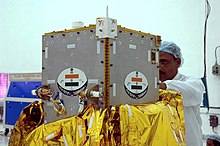Jawahar Point


Jawahar Point or Jawahar Sthal is the site near the Shackleton Crater where the Moon Impact Probe (MIP) of the Chandrayaan-1 hard landed on lunar surface on 14 November 2008.[1] The name was reportedly suggested by India's former President A. P. J. Abdul Kalam[2] as the MIP touched the Moon on the birth anniversary of India's first prime minister Jawaharlal Nehru.[3][4]
Site location
[edit]The approximate location of impact location of the probe was initially mentioned to be (89°46′S 39°24′W / 89.76°S 39.40°W)[5] but it was later refined to the Earth-facing slope of the connecting ridge between Shackleton (crater) and De Gerlache (crater) near (89°33′S 122°56′W / 89.55°S 122.93°W) by matching images from MIP camera to LROC NAC image mosaic. The exact location of MIP impact point is not known.[6]
See also
[edit]References
[edit]- ^ Images of the Moon from Chandrayaan-1 (PDF). Space Applications Centre (ISRO). 2011. p. 102. ISBN 978-81-909978-3-6. Archived from the original (PDF) on 21 October 2017. Retrieved 18 April 2019.
- ^ "Chandrayaan-1: The first time India 'touched' the Moon". The Indian Express. 23 August 2023. Archived from the original on 27 August 2023. Retrieved 27 August 2023.
You, buddy, you have done it!" Dr Kalam told Nair. To the entire control room, he said: "Today is a historic day as India has accomplished this fantastic mission. I congratulate each and every one of you!"
Before returning to New Delhi, however, he made a notable suggestion – to name the impact site after Pandit Nehru, on whose birthday the landing was made and whose vision was crucial to the creation of Isro. After receiving appropriate permissions from the government, the site was named "Jawahar Sthal - ^ "Chandrayaan-1:The Exciting Journey to Moon". Archived from the original on 20 December 2016. Retrieved 13 December 2016.
- ^ "Did India beat NASA to find water on moon?". NDTV.com. Archived from the original on 6 October 2014. Retrieved 20 December 2014.
- ^ "Note verbale dated 13 October 2009 from the Permanent Mission of India to the United Nations (Vienna) addressed to the Secretary-General" (PDF).
- ^ "lpi (iPosterSessions - an aMuze! Interactive system)". lpsc2021.ipostersessions.com. Retrieved 7 September 2023.

